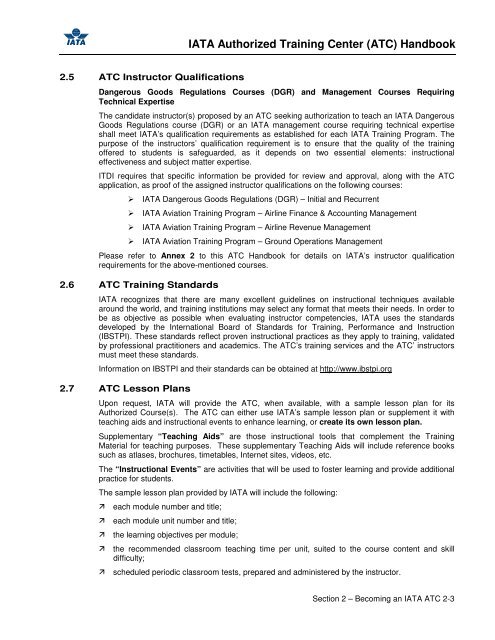ATC Handbook - IATA
ATC Handbook - IATA
ATC Handbook - IATA
Create successful ePaper yourself
Turn your PDF publications into a flip-book with our unique Google optimized e-Paper software.
<strong>IATA</strong> Authorized Training Center (<strong>ATC</strong>) <strong>Handbook</strong><br />
2.5 <strong>ATC</strong> Instructor Qualifications<br />
Dangerous Goods Regulations Courses (DGR) and Management Courses Requiring<br />
Technical Expertise<br />
The candidate instructor(s) proposed by an <strong>ATC</strong> seeking authorization to teach an <strong>IATA</strong> Dangerous<br />
Goods Regulations course (DGR) or an <strong>IATA</strong> management course requiring technical expertise<br />
shall meet <strong>IATA</strong>’s qualification requirements as established for each <strong>IATA</strong> Training Program. The<br />
purpose of the instructors’ qualification requirement is to ensure that the quality of the training<br />
offered to students is safeguarded, as it depends on two essential elements: instructional<br />
effectiveness and subject matter expertise.<br />
ITDI requires that specific information be provided for review and approval, along with the <strong>ATC</strong><br />
application, as proof of the assigned instructor qualifications on the following courses:<br />
<strong>IATA</strong> Dangerous Goods Regulations (DGR) – Initial and Recurrent<br />
<strong>IATA</strong> Aviation Training Program – Airline Finance & Accounting Management<br />
<strong>IATA</strong> Aviation Training Program – Airline Revenue Management<br />
<strong>IATA</strong> Aviation Training Program – Ground Operations Management<br />
Please refer to Annex 2 to this <strong>ATC</strong> <strong>Handbook</strong> for details on <strong>IATA</strong>’s instructor qualification<br />
requirements for the above-mentioned courses.<br />
2.6 <strong>ATC</strong> Training Standards<br />
<strong>IATA</strong> recognizes that there are many excellent guidelines on instructional techniques available<br />
around the world, and training institutions may select any format that meets their needs. In order to<br />
be as objective as possible when evaluating instructor competencies, <strong>IATA</strong> uses the standards<br />
developed by the International Board of Standards for Training, Performance and Instruction<br />
(IBSTPI). These standards reflect proven instructional practices as they apply to training, validated<br />
by professional practitioners and academics. The <strong>ATC</strong>’s training services and the <strong>ATC</strong>’ instructors<br />
must meet these standards.<br />
Information on IBSTPI and their standards can be obtained at http://www.ibstpi.org<br />
2.7 <strong>ATC</strong> Lesson Plans<br />
Upon request, <strong>IATA</strong> will provide the <strong>ATC</strong>, when available, with a sample lesson plan for its<br />
Authorized Course(s). The <strong>ATC</strong> can either use <strong>IATA</strong>’s sample lesson plan or supplement it with<br />
teaching aids and instructional events to enhance learning, or create its own lesson plan.<br />
Supplementary “Teaching Aids” are those instructional tools that complement the Training<br />
Material for teaching purposes. These supplementary Teaching Aids will include reference books<br />
such as atlases, brochures, timetables, Internet sites, videos, etc.<br />
The “Instructional Events” are activities that will be used to foster learning and provide additional<br />
practice for students.<br />
The sample lesson plan provided by <strong>IATA</strong> will include the following:<br />
each module number and title;<br />
each module unit number and title;<br />
the learning objectives per module;<br />
the recommended classroom teaching time per unit, suited to the course content and skill<br />
difficulty;<br />
scheduled periodic classroom tests, prepared and administered by the instructor.<br />
Section 2 – Becoming an <strong>IATA</strong> <strong>ATC</strong> 2-3
















